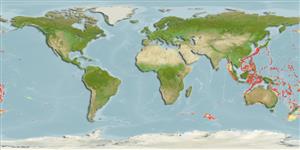Classification / Names
आम नाम | उपशब्द | Catalog of Fishes(वर्ग, प्रजाति) | ITIS | CoL | WoRMS | Cloffa
Environment: milieu / climate zone / depth range / distribution range
पारिस्थितिकी
समुद्री बाथीड़िमरसल; गहराई सीमा 216 - 794 m (Ref. 116586). Subtropical
वितरण
देश | ऐफ ऐ ओ क्षेत्र | Ecosystems | संयोग | Point map | भूमिका | Faunafri
Western Pacific, known from southern Japan, Taiwan, the northern Philippines, to off Vanuatu and Wallis and Futuna; including Eastern Indian Ocean, Timor Sea and off northwestern Australia,
आकार / वज़न / Age
Maturity: Lm ? range ? - ? cm
Max length : 11.0 cm SL पुल्लिंग / अलिंग; (Ref. 116586)
Short description
आकृति विज्ञान | मौरफोमैटरिक्स
पृष्ठीय रीढ़ (सम्पूर्ण): 10; पृष्ठीय सौफट रेज़ (सम्पूर्ण): 8-9; गुदा कांटा 2; ऐनल सौफट रेज़: 7. This slender species is distinguished by the following characters: flat dorsal head profile and pointed snout; A II + 7; pectoral-fin rays 15-16, pectoral length 19.5-24.3% SL; gill rakers 11-16, decreasing with size; pseudobranchial filaments 16-29, increasing in number with fish growth; first anal-fin pterygiophore is long, slightly bent, with moderately broad, hollow tip; vomer V-shaped with reduced dentition, only few long teeth near sides of base; palatine with 1 row of teeth, anteriorly long, posteriorly granular; ectopterygoid widened, 3-4 rows of granular teeth; orbital diameter 9.5-12.6% SL, decreasing with size; snout length 87-113 % of orbital diameter; no longitudinal ridges on the preopercular lobe; otolith moderately slender (OL:OH = 1.7-1.8) (Ref. 116586).
Life cycle and mating behavior
परिपक्व अवधि | पुनरुत्पत्ति | मछलीऔ का अंडे देना | अंडे | Fecundity | लार्वा
Schwarzhans, W.W. and A.M. Prokofiev, 2017. Reappraisal of Synagrops, Günther, 1887 with rehabilitation and revision of Parascombrops Alcock, 1889 including description of seven new species and two new genera (Perciformes: Acropomatidae). Zootaxa 4260(1):1-74. (Ref. 116586)
IUCN Red List Status (Ref. 130435)
Threat to humans
Harmless
Human uses
अधिक जानकारी
देशऐफ ऐ ओ क्षेत्रEcosystemsसंयोगभूमिकाStocksपारिस्थितिकीआहारखाद्य पदार्थआहार खपतखोराक
आम नामउपशब्दचपायचयपरभक्षीईकोटोकसीकोलौजीपुनरुत्पत्तिपरिपक्व अवधिमछलीऔ का अंडे देनाSpawning aggregationFecundityअंडेEgg development
Age/Sizeबाढ़Length-weightLength-lengthLength-frequenciesमौरफोमैटरिक्सआकृति विज्ञानलार्वालारवल गतिकीभर्तीबहुतायतBRUVS
संदर्भजलीयकृषिजलीयकृषि रूपरेखाखींचआनुवंशिकीElectrophoresesहैरेटिबिलटीबीमारीप्रक्रमणNutrientsMass conversion
सहयोगीयोतस्वीरेStamps, Coins Misc.ध्वनिसिगुयटिरारफ्तारतैरने के प्रकारगिल क्षेत्रOtolithsदिमागदृष्टि
साधन
Special reports
Download XML
इंटरनेट स्रोत
Estimates based on models
Phylogenetic diversity index (Ref.
82804): PD
50 = 0.5001 [Uniqueness, from 0.5 = low to 2.0 = high].
Bayesian length-weight: a=0.00955 (0.00424 - 0.02152), b=3.02 (2.82 - 3.22), in cm total length, based on LWR estimates for this (Sub)family-body shape (Ref.
93245).
Trophic level (Ref.
69278): 3.5 ±0.5 se; based on size and trophs of closest relatives
Fishing Vulnerability (Ref.
59153): Low vulnerability (10 of 100).
